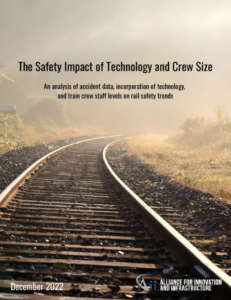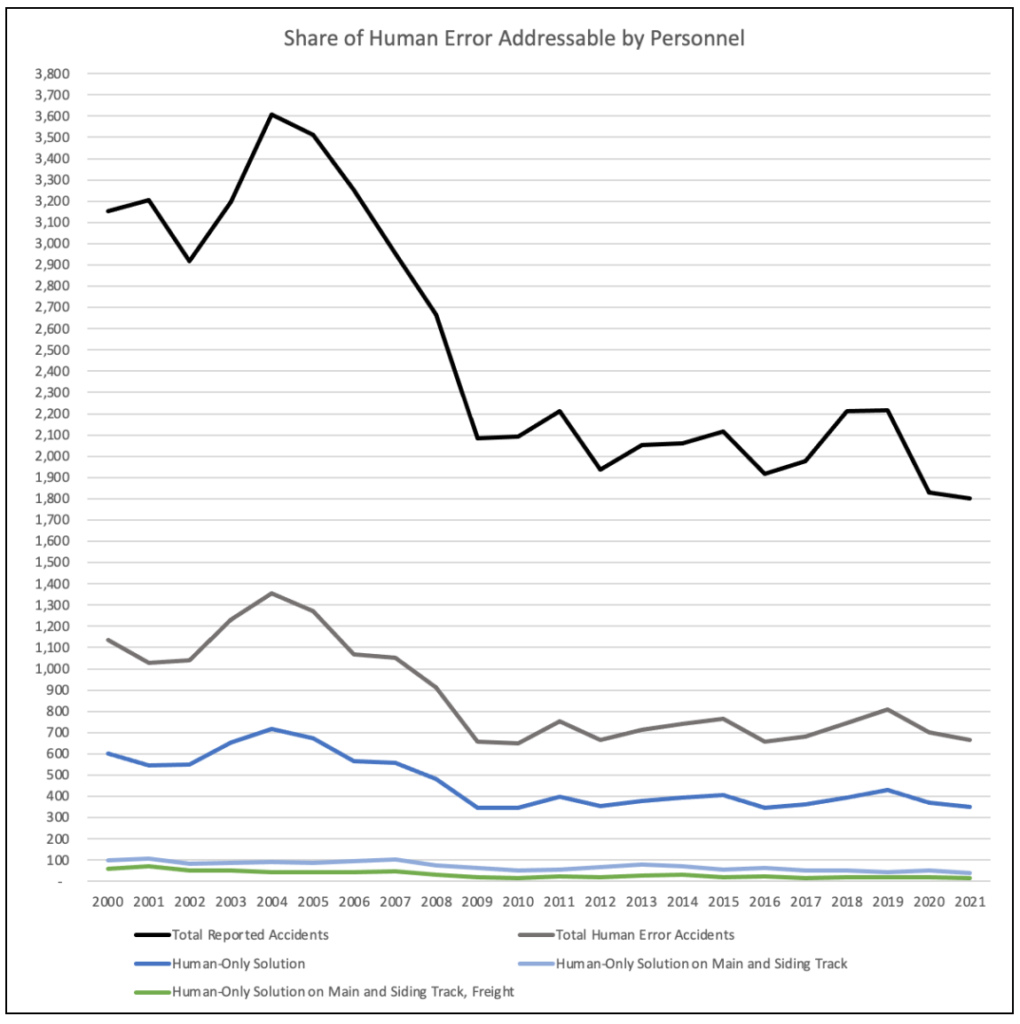 Following two significant railroad incidents in 2013, the Federal Railroad Administration (FRA) began taking a sharper look at train crew sizes. Under the theory that human error was causing substantial harm to rail workers, the public, and the environment, the FRA proposed a minimum crew size on locomotives to ensure that at least two people were properly managing the train and catching oversights. The question is, what does the data say about train crew size?
Following two significant railroad incidents in 2013, the Federal Railroad Administration (FRA) began taking a sharper look at train crew sizes. Under the theory that human error was causing substantial harm to rail workers, the public, and the environment, the FRA proposed a minimum crew size on locomotives to ensure that at least two people were properly managing the train and catching oversights. The question is, what does the data say about train crew size?
The FRA first announced that it would regulate the issue in 2014, finally rolling out its first proposed rule in 2016. Labor unions and railroad companies weighed in during the public comment period, but after deliberation and a change in political leadership, the FRA withdrew the proposed rule in 2019. Following another change in political leadership, the FRA has issued a new proposed rule in 2022 treading the same logic as the first: two crew members are needed to prevent and/or mitigate train accidents to protect workers, the public, and the environment.
The new rule affords flexibility for regional carriers or passenger rail that does not present substantial risk, but the exact judgment on those risk is somewhat in the eye of the beholder.
We began an analysis of this question to understand railroad data centered around human error. Starting with reports from the National Transportation Safety Board and exploring multiple databases from the FRA, our ultimate conclusion is twofold: there is insufficient data to justify a crew size regulation, and from what data we can discern, the rule is unwarranted.
We first looked at the proportions of human error. Across time, this has remained proportional to overall train accidents. That is, when all train accident numbers decline, the number of human error accidents also declines by the same percentage. This has mean that human error is responsible for around 35 percent of all train accidents annually.
Next, we explored the cause codes attributed to human error. These issues include failure to apply brakes, failure to apply/remove a derail, and many more. We assessed the level of technology currently integrated into the rail sector, including but not limited to positive train control (PTC). We found that approximately 47 percent of human error codes had a solution that was technological – either in that technology could address/resolve the issue all on its own (e.g. PTC applying brakes to avoid incursion into a work zone) or by alerting the engineer or conductor to an issue. The remaining 53 percent require some type of personnel to address the issue.
With 35 percent of accidents resulting from human error, and 53 percent of those requiring a human solution, there are approximately 18 percent of train accidents demanding some type of human solution.

Some of those personnel-centric solutions, however are bound by certain regulatory language. One example is the human error cause code of of having a certified/qualified operator, which no software or hardware can detect. Others are issues that can be resolved or addressed by personnel outside of the locomotive, whether they are support roles or ground-based. While roughly half of human errors do seem to require personnel, it is not the case that they require the person to be in the locomotive, which diminishes the strength of the claim that a crew size mandate is necessary.
Finally, we applied the technology and personnel analysis to freight operation on mainline track, where the regulation is primarily aimed. If Class I railroads with large payloads are a concern, it is mainline freight that should be analyzed.
The result is that the crew size rule is only aimed at approximately one percent of all train accidents across the country.

With this very narrow field of applicability, a federal regulation appears disproportionate in its costs and benefits. Moreover, technology is increasingly able to address human error within these categories. Over time, we expect these numbers to tighten further as technology is improved, integrated, and refined.
Beyond the narrow applicability, we also analyzed the ability of crew sizes to prevent and mitigate accidents. Available data from FRA accident forms indicates that there is no correlation between number of personnel and the number or severity of accidents. We could not identify data that would show that single-operator crews led to more or fewer incidents, nor that multi-member crews prevented accidents. When assessing mitigation, the severity of incidents did not diminish as higher crew counts were on duty, which we would expect if the crew were taking mitigating actions.
Overall, the data is not sufficient to justify the imposition of a federal rule on crew sizes. That is in part due to a dearth of data – with no greater example than the FRA accident form failing to capture the number and location of crew members. That means FRA does not have a dataset that documents whether the locomotives involved in train accidents had multiple crew members, taking away a key pillar of the argument that single-person crews present risk or that multi-person crews help reduce risk.
From the data we were able to analyze, the opposite conclusion was reached – that technology and single operators can safely operate moving trains and that prevention and mitigation correlations did not demonstrate multi-member crews were needed.
Importantly, Aii does not support a mass movement to single-operator freight rail. We fully support the collective bargaining process, robust integration of technology, skilled labor, and close collaboration between rail carriers, their workers, and the FRA. At this time, the best course of action is to collect better data. With particular reference to the crew size regulation, this should include updating accident reporting forms to capture crew numbers and locations and the implementation of a crew size pilot program.
To read the study in full, see the report.
Written by Benjamin Dierker, Director of Public Policy
The Alliance for Innovation and Infrastructure (Aii) is an independent, national research and educational organization. An innovative think tank, Aii explores the intersection of economics, law, and public policy in the areas of climate, damage prevention, energy, infrastructure, innovation, technology, and transportation.